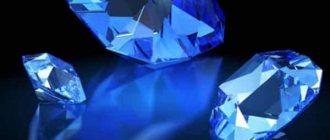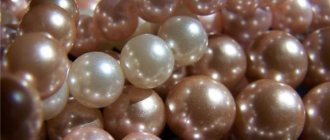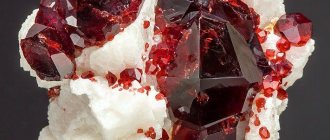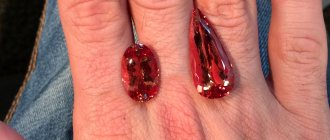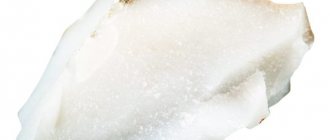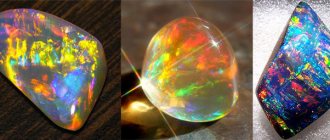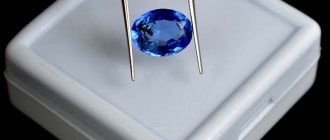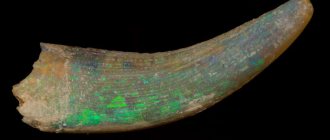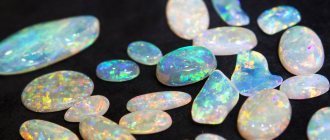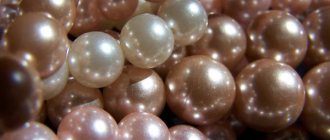Description of the stone
Externally, synthetic opal is practically indistinguishable from natural opal. High-quality fakes have physical characteristics identical to the mineral, with some improved features.
The color palette of synthetic stones includes any possible shade. Tone is imparted by diffraction without the use of dyes.
In artificial gems there is an increased density and there is no water in the composition.
In addition, the breed has certain advantages over its natural counterpart:
- cheapness;
- bright, rich color;
- beautiful shine;
- resistance to external factors;
- hardness.
See what the stone looks like in this video:
Crystal varieties and colors
According to the manufacturing method, opal is classified into several types:
- ennobled;
- synthetic.
Synthetic breed is produced in laboratories. Chemists are trying to recreate the natural conditions in which gem formation occurs. And the production time of a synthesized stone takes from one to two years.
The most famous centers for the production of synthetic opals are the Kiotsera factory and the Gilson company. They keep the manufacturing technology in the strictest confidence.
Treated stones are divided into two types:
- Doublets created from layers of natural mineral and artificial base. Black opal, the most expensive and rare variety, is most often made in this way.
- Triplets. To create them, a transparent cap (coating), layers of natural mineral and a base are used. To make the color look richer and more expressive, the rock is impregnated with smoke.
View this post on Instagram
Posted by Opal. World of Opals (@opalogram) Aug 7, 2022 at 10:30 am PDT
A variety of imitation opal: doublets and triplets
Opal doublet blue
A common type of counterfeit opal on the jewelry market are doublets. Although this is only half an imitation. This product consists of an inexpensive dark stone (usually onyx) and a plate of natural opal, which is glued on top. As a rule, black opals are imitated in this way.
Triplets consist of three components. First, an opal plate is glued onto a dark substrate made of another stone, and then a transparent dome made of another material, most often quartz glass, is glued on top. This product costs much less than natural opal.
To fasten the parts, a durable epoxy adhesive is used that is not exposed to water, solvents and acids. However, doublets and triplets cannot be kept in water for a long time, since it penetrates into the space between the glued parts and eventually destroys them.
History of the creation of the stone
Humanity learned to artificially reproduce opals back in ancient times. In Ancient Rome, cheap analogues of the mineral were made from hot glass. To do this, it was heated and sharply cooled to simulate microcracks and inclusions characteristic of the stone.
A patent for the production of artificial opals was first acquired by mineralogists from Australia A. Gaskin and P. Darré.
And in 1973, the Swiss organization of Pierre Gilson began producing high-quality synthetic gems in a wide variety of variations. Gems are in no way inferior to natural ones and even have opalescence.
There are four leading manufacturers in the world:
- The Japanese company Kyotsera, famous for opals made from various layers, impregnated with transparent colorless rubber.
- Slocum, which produces rock from a special glass with a velvety shine.
- Gilson's company. Creates stones from layers of natural opal with an artificial base.
- Inamori Corporation, which reproduces a breed almost identical to the natural one in chemical characteristics.
These organizations produce the best quality gems. Only they use substances contained in natural opal in production.
Artificial gems are also produced in Russia and China. But they make them from polymers and glass.
Where is it mined?
Most often, stone deposits look like biconvex lenses or veins in the thickness of other rocks. Large deposits are rarely found. Today, the main supplier of gems is Australia. The reason here is not only because of particularly large reserves, but also because opal mining has been going on for a very long time. Intensive development led to the fact that the mines in Europe, Asia and northern Africa were almost completely exhausted by the 19th century.
Approximately 90% of Australian gems are white crystals of varying transparency. The “capital” of stone mining is the city of Coober Pedy, South Australia. In the state of Queensland there are deposits of the boulder class mineral. And finally, the village of Lightning Ridge in New South Wales boasts a deposit of the rarest black specimens.
The leader in the production of these gems is Australia.
Other countries also supply the market with unprocessed opal, although in much smaller quantities. Gem deposits outside the kangaroo continent are known in the following countries:
- Mexico (Yucatan Peninsula);
- Honduras;
- Guatemala;
- Peru;
- United States of America, Nevada;
- Japan;
- Slovakia;
- Türkiye;
- Kazakhstan.
Fire opals, one of the rarest varieties of gemstone, are sometimes found in these countries. Stone is also found in Kamchatka and Transcarpathian Ukraine, but full-scale development of deposits in these regions is not carried out.
How to distinguish a real mineral from an imitation
Despite the low cost of natural opal, jewelry stores may try to pass it off as a fake gem. It is not difficult to distinguish between natural opal and artificial opal if you know some features about it:
- Try licking the rock. If it does not stick to the tongue, it is a sample of natural origin.
- Natural specimens have a unique pattern. On an artificial opal, the stripes will be equal in size and located at the same distance from each other.
- Synthetic opal is created by layering different materials on top of each other, so seams may be visible. A natural gem will be homogeneous in its structure.
- The natural mineral is transparent or translucent. An artificial gem will not transmit light and will not shimmer in the sun’s rays.
- Upon closer examination, air bubbles and microcracks can be detected in artificial opal. Natural contains inclusions extremely rarely.
- Most often, the color of the synthesized opal looks unnaturally bright and saturated. In a natural sample, the shade transitions are smooth and muted.
Video review on the topic:
Opal storage
You can store the opal in a convenient place, after placing it in a separate bag made of soft fabric, which will provide the required protection. But if we are talking about long-term storage, you need to put the stone on a piece of cotton wool moistened with a few drops of water, and then in a sealed plastic bag for safety. Water will not be able to absorb into the opal, since it is impenetrable, but it will prevent moisture loss in dry air conditions, for example, when there is zero humidity in a bank safe.
This is how opals are mined in mines
We hope you found this guide helpful. Take care of your opal and seek advice if you have any questions!
Physico-chemical properties of synthetic opal
Synthetic opals began to be produced due to the high cost of natural gemstones. The high cost is due to several reasons:
- opal is a rare gem, it is rarely mined;
- has a fragile structure.
Synthesized opal has some advantages. To verify this, it is enough to refer to its physical characteristics:
- the composition of the stone is dominated by polymers and glass, and may contain impurities characteristic of natural rock;
- some specimens have a formula identical to natural ones: SiO2;
- has increased density;
- hardness: 6–7 on the Mohs scale;
- can have any possible color;
- glassy, slightly matte luster;
- durability.
Tags
synthesized opal is synthesize opal and synthesized opal is synthesize opal and Synthetic opals Synthetic opals Synthetic opals white Synthetic opals synthetic opals Synthetic opals synthetic opals Synthetic opals for stone and imitate stone opal stone and stick stone or surface. The stone will Natural stone stands out Stone Tourmaline Stone Rhodonite interesting stone as a result the stone darkens Stones and Stones to distinguish natural opalnoble natural opal. inferior to natural and natural samples
buy carat articles minerals is a pink store using natural rings their earrings gold bracelets products
Jewelry with synthetic crystal
High-quality imitation is a good solution for those who love jewelry with opal, but cannot afford to buy a natural mineral.
Combining jewelry with artificial stone is not difficult because of the variety of colors in which they can be made.
Synthesized opal is extremely rarely set with precious metals.
More often these are light bracelets or other types of jewelry.
You can wear the product with any outfit. The breed will never look pretentious or inharmonious. Jewelry goes well with everyday wear.
View this post on Instagram
Posted by Rainbow Art Gallery (@yantargold_galery) March 19, 2022 at 2:59 PDT
View this post on Instagram
Publication from Author's jewelry Natalika? (@natalika_handmade) Sep 12, 2022 at 7:25 PDT
View this post on Instagram
Publication from ⚪️JEWELRY⚪️ALINA⚪️ (@a_la_cherie) May 10, 2016 at 9:15 PDT
How to wear and care for the breed
Jewelry with unnatural stone is easy to handle and very durable. Therefore, there will be few rules for caring for it:
- Clean the product with soapy water whenever it becomes dirty. It’s not scary if you use soap and a toothbrush, but it’s better not to overdo it.
- The only reason opal should be stored separately from other stones is because they can scratch natural minerals.
- But try to avoid mechanical impacts on the breed. Even a synthesized gem can crack or chip.
Also, see what a stone looks like in a gold item:
Applications
Opal is used in the jewelry industry, and small fragments are used in beauty salons to decorate nails. Polished stone plates are attached on top of onyx, obsidian, and black glass. Due to its low strength, opal was impregnated with artificial resins, oils were applied to its surface, and strong frames were made for it.
Stone chips and small specimens can serve as decorations for buttons, hairpins, brooches, cufflinks, wallets, caskets and other accessories.
Rocks containing opal - diatomites, tripoli, opoka - raw materials for the production of cement and other building materials.
Stone cost
Natural opal is several times more expensive than artificial opal. The cheapness of the stone is another advantage over its natural counterpart. Artificial stone jewelry can be purchased for up to 500 rubles.
Making products using synthesized stone makes them affordable, and customers are satisfied with the quality and appearance of the reproduced opal.
The only drawback of artificial stone is the lack of magical, healing properties.
Would you buy jewelry with synthesized opal or are you closer to natural minerals? Exchange your thoughts in the comments and share information on social networks.
Opal: who suits it according to their zodiac sign?
Astrologers assure that stones should also be selected based on your zodiac sign. Thus, if the mineral corresponds and suits your sign, then it will bring only benefit to your life and cannot cause harm.
Which zodiac sign does opal suit?
- This is a stone that is ideal for people under the zodiac signs of Libra and Scorpio. This means people who were born in October. This stone will help them realize themselves in life and attract luck to their side.
- But for fire signs, such as Aries, Sagittarius and Leo, opal of almost all types is strictly contraindicated. We only allow fire opal, which will emphasize their element. These signs are already purposeful, so the power of the stone can become a counterweight in the realization of their desires. It can also suppress their inner potential.
Opal is not suitable for all zodiac signs
- Opal to such an unrestrained sign like Taurus . Representatives of this sign are best suited for white opal with a pearlescent tint.
- Opal for Gemini will not bring anything new into their lives. For them, jewelry made from this stone will remain just jewelry.
- Opal for Cancer is black and white. The mineral of these flowers will attract good luck and financial well-being to their side.
- Virgo is an energetically strong sign. Fire opal for Virgo will help them become a little kinder to others and make them less demanding.
- Capricorns are distinguished by their stubbornness, and sometimes even tediousness. Opal for Capricorn will be an excellent talisman and will help soften the previously mentioned qualities. Did you like fire opal? A great choice for a new decoration or talisman.
- Aquarius is a very hot-tempered sign and is often led by emotions. And opal for Aquarius will be like a guide to calm. The stone will make them more balanced. Pay attention to your intuition when choosing the color of the stone.
- Pisces is a sign that relies on its developed intuition always and in everything. It is opal for Pisces that will help them improve this quality in themselves. For this purpose, the most successful option would be pink and white opal.

